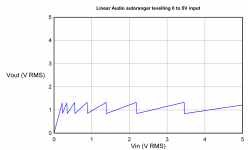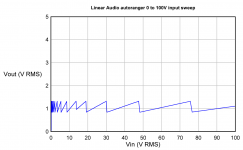Yes, there is. One of the last issues was whether to AC-couple the outputs or not. In the single ended input mode, there is a DC source imbalance between the input channels due to a measure taken to suppress noise from the unused channel. I just did some measurements to compare different opamps to find the best one for low offset AND low distortion. Guido Tent kindly allowed me to spend some time on their AP2722.
See attached.
Unfortunately, the only real conclusion seems to be we need a better AP
Or - why did I sell my distortion magnifier...?
OTOH, both the LM4562 (LME49720) and the OPA2134 seem to do well. (I have another test with the OPA627 that also comes out quite well but that adds $ 50 to the BOM....).
Other than this last issue, everyting is basically done. I still have some work to do to finalize the switcher Kickstarter but next up is the AR.
Jan
See attached.
Unfortunately, the only real conclusion seems to be we need a better AP
Or - why did I sell my distortion magnifier...?
OTOH, both the LM4562 (LME49720) and the OPA2134 seem to do well. (I have another test with the OPA627 that also comes out quite well but that adds $ 50 to the BOM....).
Other than this last issue, everyting is basically done. I still have some work to do to finalize the switcher Kickstarter but next up is the AR.
Jan
Attachments
Last edited:
The autoranger development and testing is done. I am putting together 3 autorangers for beta testing by other people. If it all pans out I intend to do a Kickstarter project, but that will be very end of the year.
I'll be updating https://linearaudio.nl/la-autoranger in the next week.
Thanks for the interest!
Jan
I'll be updating https://linearaudio.nl/la-autoranger in the next week.
Thanks for the interest!
Jan
Great work.The autoranger development and testing is done. I am putting together 3 autorangers for beta testing by other people. If it all pans out I intend to do a Kickstarter project, but that will be very end of the year.
I'll be updating https://linearaudio.nl/la-autoranger in the next week.
Thanks for the interest!
Jan
I'm living in the EU and have a QA401, if you still need a beta tester
Cable?
Hello,
Assuming that this AutoRanger will connect to the current version of the QA401 Analyzer, I am trying to conger up how a set of cables will be configured.
The output of the AR is SE and Bal made with a TRS. The input of the QA401 is also SE and Bal. I presume that optimal performance including noise will be balanced. For balanced operation I am picturing a DIY cable with a TRS on one end and on the other end a pair of male BNC’s.
DT
Yes the SE input is RCA, the Bal input is a combo XLR/TRS. The outputs (SE and Bal) are TRS.
That fits best with most sources and soundcards.
Jan
Hello,
Assuming that this AutoRanger will connect to the current version of the QA401 Analyzer, I am trying to conger up how a set of cables will be configured.
The output of the AR is SE and Bal made with a TRS. The input of the QA401 is also SE and Bal. I presume that optimal performance including noise will be balanced. For balanced operation I am picturing a DIY cable with a TRS on one end and on the other end a pair of male BNC’s.
DT
I'm not sure you need the autoranger with a QA401. It has similar functionality built in. The only limit is max voltage at 20V RMS. You could make a dummy load with built in divider and make that 200V equivalent and never worry about range, plus get the signal to the most accurate, lowest distortion part of the range.
The autoranger is appropriate for the QA400 or a soundcard where the input limits are more circumscribed.
The autoranger is appropriate for the QA400 or a soundcard where the input limits are more circumscribed.
Noise-Floor
Hello,
How much do you need to spend for fun? The QA401 looks to be plenty useful as is.
The Autoranger looks to be a nice piece of equipment as well. The QA401 has a single 20db attenuator. The AR has a series of 4db steps of attenuation for high level inputs with the goal of maintaining about 1 volt output. I like the idea of using the dbV scale on a FFT plot. With one volt input to the QA401 that 1 volt 1st Harmonic will be very near 0 dbV.
For lower level inputs the AR will boost the signal, again in an effort to output about 1 volt. This amplification of a low level signal effectively lowers the noise floor and increases the sensitivity of the QA401. Check this out.
QuantAsylum Home Page
DT
I'm not sure you need the autoranger with a QA401. It has similar functionality built in. The only limit is max voltage at 20V RMS. You could make a dummy load with built in divider and make that 200V equivalent and never worry about range, plus get the signal to the most accurate, lowest distortion part of the range.
The autoranger is appropriate for the QA400 or a soundcard where the input limits are more circumscribed.
Hello,
How much do you need to spend for fun? The QA401 looks to be plenty useful as is.
The Autoranger looks to be a nice piece of equipment as well. The QA401 has a single 20db attenuator. The AR has a series of 4db steps of attenuation for high level inputs with the goal of maintaining about 1 volt output. I like the idea of using the dbV scale on a FFT plot. With one volt input to the QA401 that 1 volt 1st Harmonic will be very near 0 dbV.
For lower level inputs the AR will boost the signal, again in an effort to output about 1 volt. This amplification of a low level signal effectively lowers the noise floor and increases the sensitivity of the QA401. Check this out.
QuantAsylum Home Page
DT
To wet your appetite, here is an input-output sweep of the autoranger with an input of 0 to 5V. and a sweep from 0 to 100V.
Jan
Nice.
What's the threshold 0.5V?
How about using the pin to select between two different values of hysteresis? Zero hysteresis and 15% hysteresis, for example.
Then if the input amplitude wanders a few percent AND if, at the same time, it's right at a range switching boundary, the autorange won't oscillate.
Then if the input amplitude wanders a few percent AND if, at the same time, it's right at a range switching boundary, the autorange won't oscillate.
Use that extra pin
Hello Jan,
When I read the question about “threshold” I went off track in the direction of, how low of an input voltage will output “about” 1 Volt. I recall reading on you page somewhere around 0.1 V to 0.15 V. (16 dB gain)
Is there any ability to use that extra pin to increase the AR gain to 40 dB to resolve low level distortion and noise. MerlinB used a 100X preamplifier to study tube noise vs frequency.
Thanks
DT
No, the overrange/underrage switching limits are like 1.3V and iirc 0.7V. It''s set in the firmware. I have one pin left for a jumper so could provide two ranges, jumper selected, in the final version.
Any ideas? Should be nominal +/- 30% or thereabouts.
Jan
Hello Jan,
When I read the question about “threshold” I went off track in the direction of, how low of an input voltage will output “about” 1 Volt. I recall reading on you page somewhere around 0.1 V to 0.15 V. (16 dB gain)
Is there any ability to use that extra pin to increase the AR gain to 40 dB to resolve low level distortion and noise. MerlinB used a 100X preamplifier to study tube noise vs frequency.
Thanks
DT
AutoRanger
I agree, Jan, please notify me when this goes live and I'm in.
Thanks!
Howie
Howard Hoyt
CE - WXYC-FM 89.3
UNC Chapel Hill, NC
diyAudio server HTTPS page
Hi Jan,
That board is pretty neat and professional looking. Nicely done sir!
I agree, Jan, please notify me when this goes live and I'm in.

Thanks!
Howie
Howard Hoyt
CE - WXYC-FM 89.3
UNC Chapel Hill, NC
diyAudio server HTTPS page
Hello Jan,
Question(s) about the output of the Autoranger.
The Autoranger will connect to either Balanced or SE sound cards. Have you measured the noise and distortion performance in the SE and Bal applications?
Even if there is a SE input to the AR I suspect that there will be better performance when the AR connection to the soundcard is balanced.
DT
Question(s) about the output of the Autoranger.
The Autoranger will connect to either Balanced or SE sound cards. Have you measured the noise and distortion performance in the SE and Bal applications?
Even if there is a SE input to the AR I suspect that there will be better performance when the AR connection to the soundcard is balanced.
DT
I have spend some time with an AP system 2722 Cascade, which I do not own myself (thank you Guido Tent!).
The only thing I found out is that there is no difference between the AP residual with the AR or the loop through, at 1kHz and 5kHz. Residual about -118dB 2nd and lower 3rd.
I also tried with a Victor 1kHz and 5 kHz oscillator, but with basically the same result.
I will eventually do a full measurement set but so far the real challenge is the test equipment rather than the AR
Jan
The only thing I found out is that there is no difference between the AP residual with the AR or the loop through, at 1kHz and 5kHz. Residual about -118dB 2nd and lower 3rd.
I also tried with a Victor 1kHz and 5 kHz oscillator, but with basically the same result.
I will eventually do a full measurement set but so far the real challenge is the test equipment rather than the AR
Jan
- Home
- Design & Build
- Equipment & Tools
- Autoranger for soundcards

